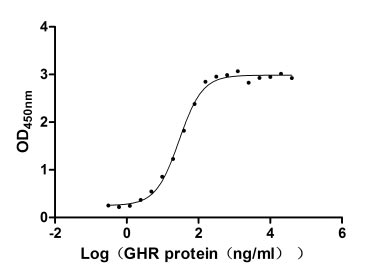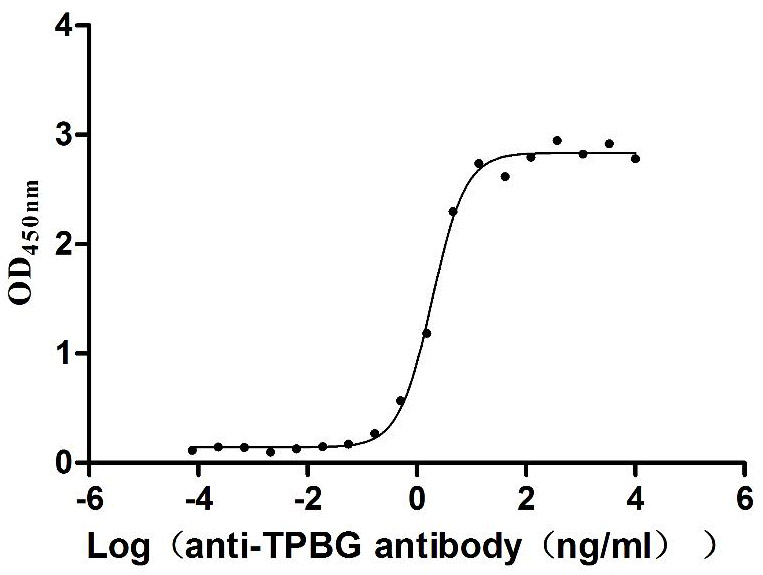Recombinant Human Voltage-dependent T-type calcium channel subunit alpha-1I (CACNA1I), partial
-
中文名稱:Recombinant Human Voltage-dependent T-type calcium channel subunit alpha-1I(CACNA1I) ,partial
-
貨號:CSB-YP885788HU
-
規(guī)格:
-
來源:Yeast
-
其他:
-
中文名稱:Recombinant Human Voltage-dependent T-type calcium channel subunit alpha-1I(CACNA1I) ,partial
-
貨號:CSB-EP885788HU
-
規(guī)格:
-
來源:E.coli
-
其他:
-
中文名稱:Recombinant Human Voltage-dependent T-type calcium channel subunit alpha-1I(CACNA1I) ,partial
-
貨號:CSB-EP885788HU-B
-
規(guī)格:
-
來源:E.coli
-
共軛:Avi-tag Biotinylated
E. coli biotin ligase (BirA) is highly specific in covalently attaching biotin to the 15 amino acid AviTag peptide. This recombinant protein was biotinylated in vivo by AviTag-BirA technology, which method is BriA catalyzes amide linkage between the biotin and the specific lysine of the AviTag.
-
其他:
-
中文名稱:Recombinant Human Voltage-dependent T-type calcium channel subunit alpha-1I(CACNA1I) ,partial
-
貨號:CSB-BP885788HU
-
規(guī)格:
-
來源:Baculovirus
-
其他:
-
中文名稱:Recombinant Human Voltage-dependent T-type calcium channel subunit alpha-1I(CACNA1I) ,partial
-
貨號:CSB-MP885788HU
-
規(guī)格:
-
來源:Mammalian cell
-
其他:
產(chǎn)品詳情
-
純度:>85% (SDS-PAGE)
-
基因名:
-
Uniprot No.:
-
別名:CACNA1I; KIAA1120; Voltage-dependent T-type calcium channel subunit alpha-1I; Voltage-gated calcium channel subunit alpha Cav3.3; Ca(v)3.3
-
種屬:Homo sapiens (Human)
-
蛋白長度:Partial
-
蛋白標(biāo)簽:Tag?type?will?be?determined?during?the?manufacturing?process.
The tag type will be determined during production process. If you have specified tag type, please tell us and we will develop the specified tag preferentially. -
產(chǎn)品提供形式:Lyophilized powder
Note: We will preferentially ship the format that we have in stock, however, if you have any special requirement for the format, please remark your requirement when placing the order, we will prepare according to your demand. -
復(fù)溶:We recommend that this vial be briefly centrifuged prior to opening to bring the contents to the bottom. Please reconstitute protein in deionized sterile water to a concentration of 0.1-1.0 mg/mL.We recommend to add 5-50% of glycerol (final concentration) and aliquot for long-term storage at -20℃/-80℃. Our default final concentration of glycerol is 50%. Customers could use it as reference.
-
儲存條件:Store at -20°C/-80°C upon receipt, aliquoting is necessary for mutiple use. Avoid repeated freeze-thaw cycles.
-
保質(zhì)期:The shelf life is related to many factors, storage state, buffer ingredients, storage temperature and the stability of the protein itself.
Generally, the shelf life of liquid form is 6 months at -20°C/-80°C. The shelf life of lyophilized form is 12 months at -20°C/-80°C. -
貨期:Delivery time may differ from different purchasing way or location, please kindly consult your local distributors for specific delivery time.Note: All of our proteins are default shipped with normal blue ice packs, if you request to ship with dry ice, please communicate with us in advance and extra fees will be charged.
-
注意事項:Repeated freezing and thawing is not recommended. Store working aliquots at 4°C for up to one week.
-
Datasheet :Please contact us to get it.
相關(guān)產(chǎn)品
靶點詳情
-
功能:Voltage-sensitive calcium channels (VSCC) mediate the entry of calcium ions into excitable cells and are also involved in a variety of calcium-dependent processes, including muscle contraction, hormone or neurotransmitter release, gene expression, cell motility, cell division and cell death. This channel gives rise to T-type calcium currents. T-type calcium channels belong to the 'low-voltage activated (LVA)' group and are strongly blocked by nickel and mibefradil. A particularity of this type of channels is an opening at quite negative potentials, and a voltage-dependent inactivation. T-type channels serve pacemaking functions in both central neurons and cardiac nodal cells and support calcium signaling in secretory cells and vascular smooth muscle. They may also be involved in the modulation of firing patterns of neurons which is important for information processing as well as in cell growth processes. Gates in voltage ranges similar to, but higher than alpha 1G or alpha 1H.
-
基因功能參考文獻:
- analyses suggest that a single copy of Chr22: 39665939G > A CACNA1I has the capacity to disrupt CaV3.3 channel-dependent functions, including rebound bursting in TRN neurons, with potential implications for schizophrenia pathophysiology. PMID: 27756899
- low-voltage activation characteristics of CaV3.3 channels PMID: 29474447
- CACNA1I is a risk gene for schizophrenia in the Han Chinese population PMID: 29308060
- human Cav3.1, Cav3.2, and Cav3.3 T-type channels specifically associate with CaM at helix 2 of the gating brake in the I-II linker of the channels. PMID: 28972185
- In gastric cancer, expression of all the CACNA (1G, 1H, 1I) genes was associated with overall survival (OS) among stage I-IV patients. By combining the three potential biomarkers, a TTCC signature was developed, which retained a significant association with OS both in stage IV and stage I-III patients. Alterations in CACNA gene expression are linked to tumour prognosis. PMID: 28846697
- significant association exists between the CACNA1I gene and schizophrenia in the Uighur Chinese population PMID: 28725167
- CACNA1I variant is associated with differential antiepileptic drug response in childhood absence epilepsy. PMID: 28165634
- CaV3.1, CaV3.2 and CaV3.3 channels, are best recognized for their negative voltage of activation and inactivation thresholds that allow them to operate near the resting membrane potential of neurons. PMID: 26488564
- Extracellular pressure increases [Ca(2+)]i via Cav3.3, driving a PKC-beta- IKK- IkB-NF-kB pathway that stimulates cancer cell proliferation PMID: 25454347
- Ethanol primarily affects the CaV3.2 isoform of T-type Ca(2)+ channels, acting through protein kinase C. PMID: 23488970
- Specific contribution of human T-type calcium channel isotypes (alpha(1G), alpha(1H) and alpha(1I)) to neuronal excitability. PMID: 11927664
- intracellular regions after repeats I and IV play a role in gating interdependently, suggesting a direct interaction, and splice variation of Cav3.3 channels provides a mechanism for fine-tuning latency and duration of low-threshold spikes. PMID: 15254077
- CatSper1 and CatSper2 can associate with and modulate the function of the Ca(v)3.3 channel, which might be important in the regulation of sperm function. PMID: 16740636
- two distinct regions of the Cav3.3 channel are necessary and sufficient for complete M1 receptor-mediated channel inhibition PMID: 17535809
- The sodium channel toxins tetrodotoxin and saxitoxin interact with the alpha-subunit of T-type Ca 2+ channels. PMID: 18591418
顯示更多
收起更多
-
亞細(xì)胞定位:Membrane; Multi-pass membrane protein.
-
蛋白家族:Calcium channel alpha-1 subunit (TC 1.A.1.11) family, CACNA1I subfamily
-
組織特異性:Brain specific.
-
數(shù)據(jù)庫鏈接:
Most popular with customers
-
Recombinant Human Growth hormone receptor (GHR), partial (Active)
Express system: Mammalian cell
Species: Homo sapiens (Human)
-
Recombinant Human HLA class II histocompatibility antigen gamma chain (CD74), partial (Active)
Express system: Mammalian cell
Species: Homo sapiens (Human)
-
Recombinant Human G-protein coupled receptor family C group 5 member D (GPRC5D)-VLPs (Active)
Express system: Mammalian cell
Species: Homo sapiens (Human)
-
Recombinant Macaca fascicularis Trophoblast glycoprotein (TPBG), partial (Active)
Express system: Mammalian cell
Species: Macaca fascicularis (Crab-eating macaque) (Cynomolgus monkey)
-
Recombinant Human Killer cell immunoglobulin-like receptor 3DL2 (KIR3DL2), partial (Active)
Express system: Mammalian cell
Species: Homo sapiens (Human)
-
Recombinant Human Interleukin-12 receptor subunit beta-1(IL12RB1),partial (Active)
Express system: Mammalian cell
Species: Homo sapiens (Human)



-AC1.jpg)













